Review | Wars of Napoleon
It’s been a busy year for The World’s Conqueror, Napoleon with Victory and Glory: Napoleon, Quatre Bras (an expansion for Scourge of War), and Wars of Napoleon all launching in the first half of the year alone.
Each of the games approach Napoleon’s time as Emperor in different ways; Quatre Bras is an in-combat, battlefield romp focusing on moving squads of men around a 3D battlefield; Victory and Glory: Napoleon is a grand-scale, large regional tiled tactical affair with a card system and streamlined troop management; Wars of Napoleon is as close to what I consider grand strategy as it can get – individual battalions form into groups, into corps under generals, into armies under generals, all the way up to the top – and you can define that from top to bottom. That and it plays out across a regional map that drills down to the county level across the contested globe – it’s in depth, and it’s also well organised enough to be accessible to the strategy/tactical dabbler that I am.
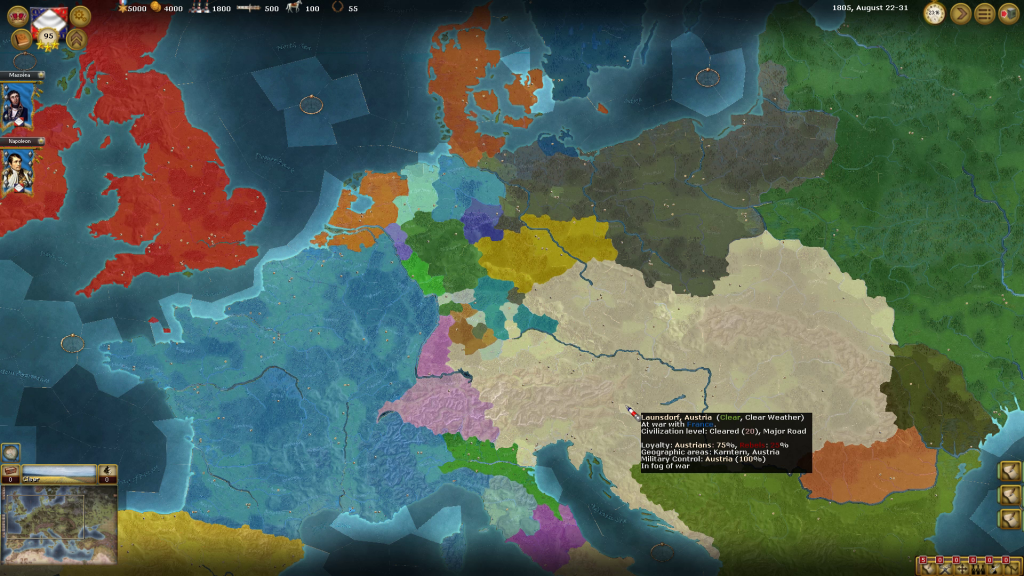
As I’m as close to a certified cartophile as you can be, I was massively impressed with the game map – 4000~ regions dividing the world down into geographic counties as opposed to regions, or hexes, or tiles. I was really quite taken aback by the river and terrain detail placement and how the world was divvied up. The map is floating in the middle of 2D and 3D, with various small features projecting from it. In addition to the appealing appearance of the map it’s laid out very practically, with the wastelands and areas which can’t be traversed holding small inserts which featured important cities and regions which wouldn’t have otherwise been shown on the extremely large map’s renditions of Europe, West Asia, The Near East & Northern Africa.
In fact, these inserts show off areas which can be interacted with, manned cities and regions which played parts during those ten years, from the West Indies, Siberia, Persia, Madagascar to India and beyond, they’re all are shown dotted around the outskirts of the map – these colonies or factions all playing a part and manned in the various campaigns if the game’s events should take them down that route. All of those regions are used differently depending on which of the 6 currently included scenarios you select.
The game includes three long term campaigns, extending from 1805 through to 1815. These include a January start (requiring more preparation), an August start (where Napoleon’s forces were already mobilised), and a what if scenario where Napoleon has already taken Hastings and has to move up England. This means, in any of these, you can push through from the starting turns and completely divert history away from the events leading to Nelson’s death, Napoleon’s defeat at Leipzig or Waterloo, or even the collapse of the early coalitions if you can manage as such. In these longer campaigns you have a choice from many of the combatants in the game, with it offering France, Great Britain, Prussia, Russia, Austria, Spain, and the Ottoman Empire as playable parties.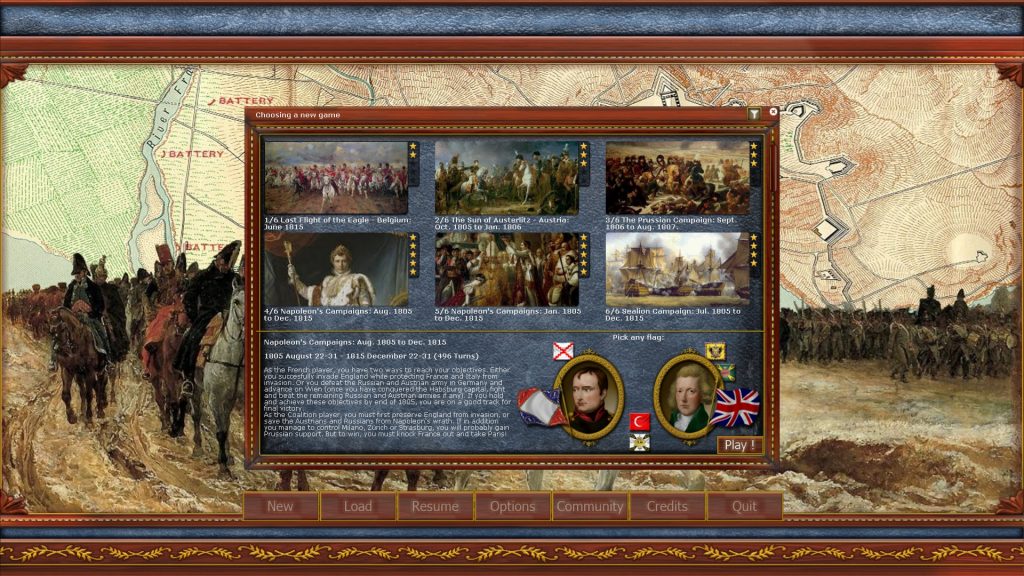
In addition to these six there’s also three smaller scenarios – Austerlitz, Jena & Waterloo, all focusing on different styles of combat, and requiring great effort to push back history if you’re playing the underdogs.
The three smaller scenarios are simply games of give or take, playing out more like a traditional tactics game – with it’s limited troop types and a simple attack or hold objective. The other ones, the various long term campaigns made of about 500 turns, are where the game really comes alive with the extra management/development options. While you’re certainly not developing technologies, or building anything with civilians in mind, you are gaining resources from the land held, and with that you can buy in more units and set up supply points. There’s also a card system in the game – as seems to feature in so many Matrix titles – which allows for costly -and as such limited- major game changers to be played by the player as to tilt recruitment, resource gain, or supplies into your favour. These cards, much like most of the game’s interface, work on a simple drag-drop interface.
Troop formation and hierarchy is managed in that easy drag-drop manner too – a general can be dragged away from the core pile they are within in order to start a new group, units can then be dragged between the two generals as to redistribute them. It’s extremely user friendly and accessible. As a matter of fact, this simple interaction system doesn’t end with the cards and group formation/movement. Certain regions on the map might become clustered after a big battle involving many forces, however units are not locked onto a central spot on the region, they can be dragged around the small tile meaning you can easily move a unit out of the way of another that you want to see – all of this without affecting turns or movement. This is certainly something I really appreciated and should be held up as something to be in all titles of this type going forward.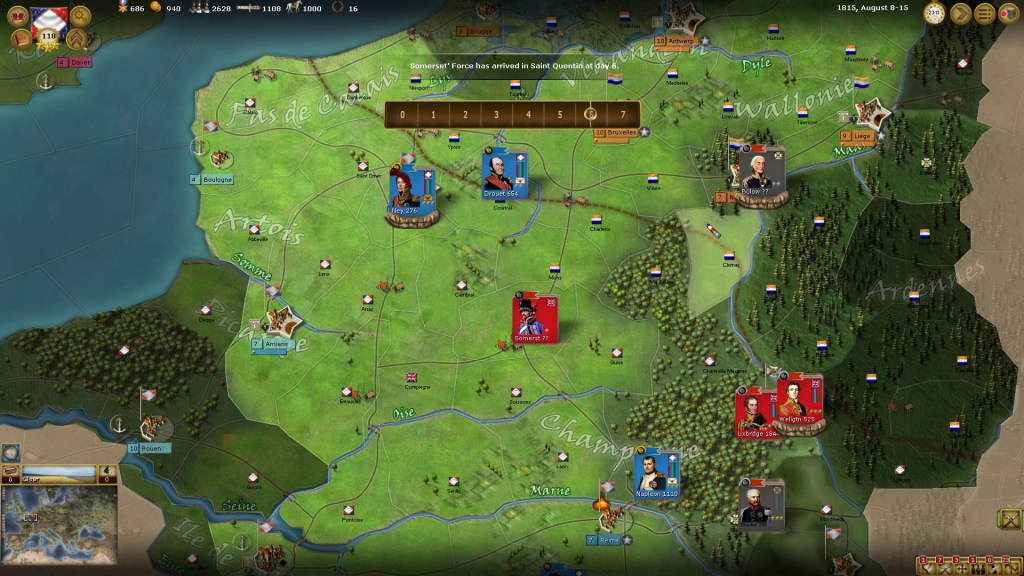
Obviously, as fun as it is to remove Masséna, Napoleon, Wellington, Ney, Murat, etc, etc, from power and restructure your armies and divisions in a nonsensical manner, there are mechanics in place to ensure that the more respectable and efficient commanders remain at the top – well, if you want a more streamlined time, and possibly a smoother war. Each regiment require a certain amount of command points in order to work at it’s most efficient, these trickle down the chain of command, with the superior officers (with higher command ratings) offering more points down the chain. In the three short campaigns you hardly notice this. However, if you play a longer campaign, turtle up and make a lot more troops while also not adjusting your hierarchy at the same time you’ll notice troops begin to falter and you lose momentum as you extend across the reaches of Europe.
Turns, as I mentioned earlier, the game is turn-based, encompass 7 days. Which then play out when you end your turn. It’s an odd decision for me, this game really, really grabbed me from first boot due to it’s similarities to Paradox Interactive’s Hearts of Iron series. That said, it quickly becomes manageable, however it does lead me overly aware of turns wasted at not being able to stack multiple actions during that week. It means that if a unit is told to engage an enemy in an adjacent tile you cannot tell them to move to a further location, then another, in the remaining days of the week. It certainly took me a little getting used to.
Combat, that said, plays out purely on the automatic, the various compositions, morale and numbers of the troops on either side playing out in a deadly dance. Interestingly the combat also follows the ticking of the days throughout the turn, meaning that a battle might take some serious time, but also that they might (and often do) see reinforcements arrive to relieve and strengthen their respective forces as the week progresses. I say combat is purely on the automatic, you do control it in regards to those elements earlier mentioned ; composition, morale, quantities – but also, on the larger battles, you can submit an overall battle tactic. These can range from a simple selection of three, into a more in-depth and targeted focus of that tactic. I didn’t run any experiments as to see the effect this had on combat, however when equipped with scouted knowledge about the enemy, and awareness of their plans for combat, playing tactics which naturally countered them saw me win some battles against overwhelming odds. This is something worth shouting about, normally war games of any scale cannot emulate the effects of solid flanking, historical underdogs, or just the lucky soldier who manages to survive the battle against all odds as to return to their family. Having a game where my smaller force outmaneuvered an enemy to secure victory – in the way Napoleon was notorious for doing – is fantastic.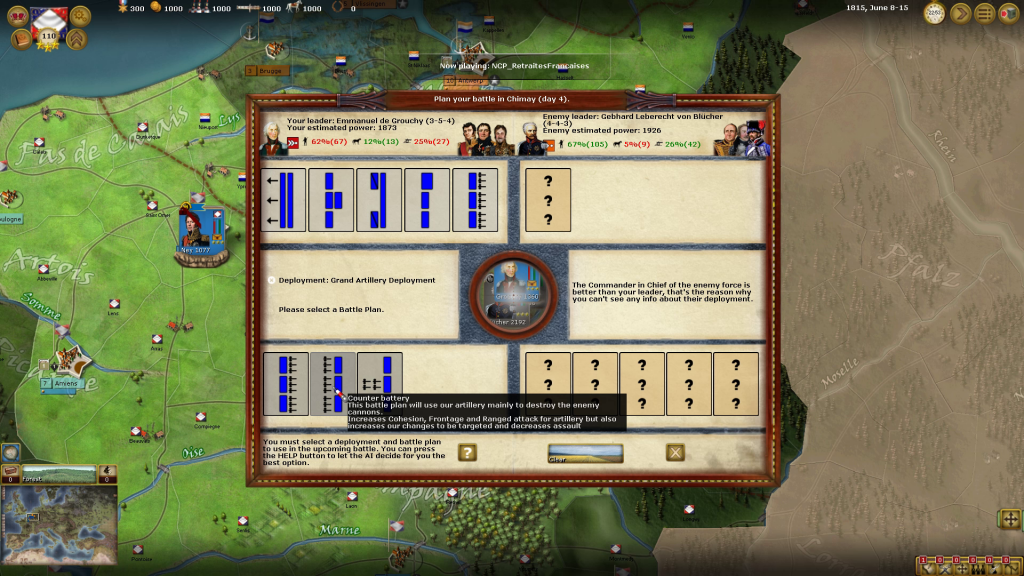
Combat is, naturally an important part of the game, with any smaller skirmishes requesting you capture select enemy districts over anything else. Of course armed forces only run well if they are well supplied, and the game does a good job of having an easy to manage supply system. Towns will naturally supply nearby forces, however in freshly captured territory supply bases must be built to lengthen the chain, and when in enemy territory your forces operate from scavenging or the movement of caravans at your command. Importantly the game actually shows you how the supplies are distributed by pairing said supplies with the units themselves, meaning you can see that your infantry unit currently in Essex only has 6/8 ammunition required. All of this information is displayed on the cards, or alternately with tooltips. Frustratingly – for me – tooltips seem to be forced on, something I’ve really grown to dislike. If I want to view information on a unit I’ll happily click it, or hold a key in order to have the information pop off. I even rooted around in the menu to see if there’s a toggle option for it. There isn’t.
I much preferred to use the presented information down the bottom of the screen per unit, or the ledger, for information. The ledger – as one might expect from the name is a veritable gold mine of statistics and sortable data. I have a reputation among the team that says if I was left in front of an Access database and Excel spreadsheet I’d manage to find fun in it – it’s true I’m a glutton for data, useful data. The ledger is fantastic for this, and an essential tool when you are conquering the world.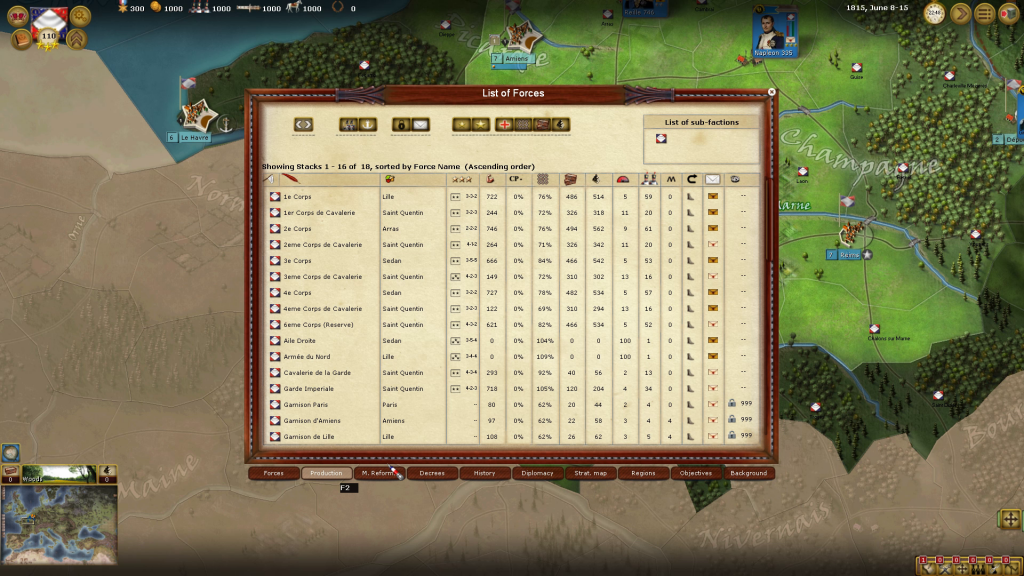
To return to the visuals of the game, having stated how much I enjoyed the map earlier, the period artwork in the game is also exceptional. There’s around 400 named generals in the game, each with portraits from the period, or in the style of the period. There’s also around 300 troop uniforms reflecting nationalities and government reform. Finally, the card -and menu- artwork is magnificent.
I did experience a few issues with the game that really stuck out, and from looking around and across forums they appear to have not been limited to myself – instead down to a well worn engine. When I zoomed out rapidly the game slowed, jumping moments of music and generally dipping in performance – this is likely due to the sheer amount of content being handled at that moment, although considering it as a turn based title it certainly felt odd when compared to the refined performance of Firaxis’ recent entries into the Civilization series (managing zoom outs through minimising rendered assets), or Paradox’s Clausewitz engine’s performance which deals with a much larger (if differently handled) database but manages to retain integrity until the later stages of a long game (on my computer setup). That said, even in longer games (I got about 300 turns into a long campaign) the engine runs smooth if kept at the low levels.
The AI doesn’t quite work how I might have expected sometimes, although my main history in games of this scale is with enemies set to snatch targets and siege strongholds. In this, even when on the offensive, certain generals seem to act with limited awareness of critical points, instead opting to split troops and attempting to hide at the flanks, aiming to patiently wait for your forces to move from it’s targets as to sweep in with minimal conflict. This certainly sounds smart in words, but in game it means you can simply leave a decent sized troop in your border cities to nearly entirely halt invasion efforts from all but French and English forces.
I have to mention, before I head to my conclusion, that the sliders and toggles in the options menus pertaining to difficulty and scenario settings are fantastic. There are 8 toggles which flip certain historical influences to either French or English sides. Example, Americans pledge to help the French against the English. These, and the SLIDERS for difficulty, etc, allow a massive amount of tweaking – which surely massively increases accessibility for the game.
In conclusion, this is most definitely one of the most accessible and easy to understand titles I’ve played from the Matrix catalogue. If it wasn’t for the creaking joints of an aged engine the game would be near pristine, and barring the quirks that it brings (like forced tooltips) the game was exceptionally enjoyable. Yes, the AI is strange, but in Grand Strategy games (which this definitely is, over ‘turn based tactical’) AI is notoriously hard to balance, I’m just pleased the AI never felt particularly over powered, and any flaw in my armies felt like it was an echo of a stupid decision I’d made earlier.
Comments are closed.